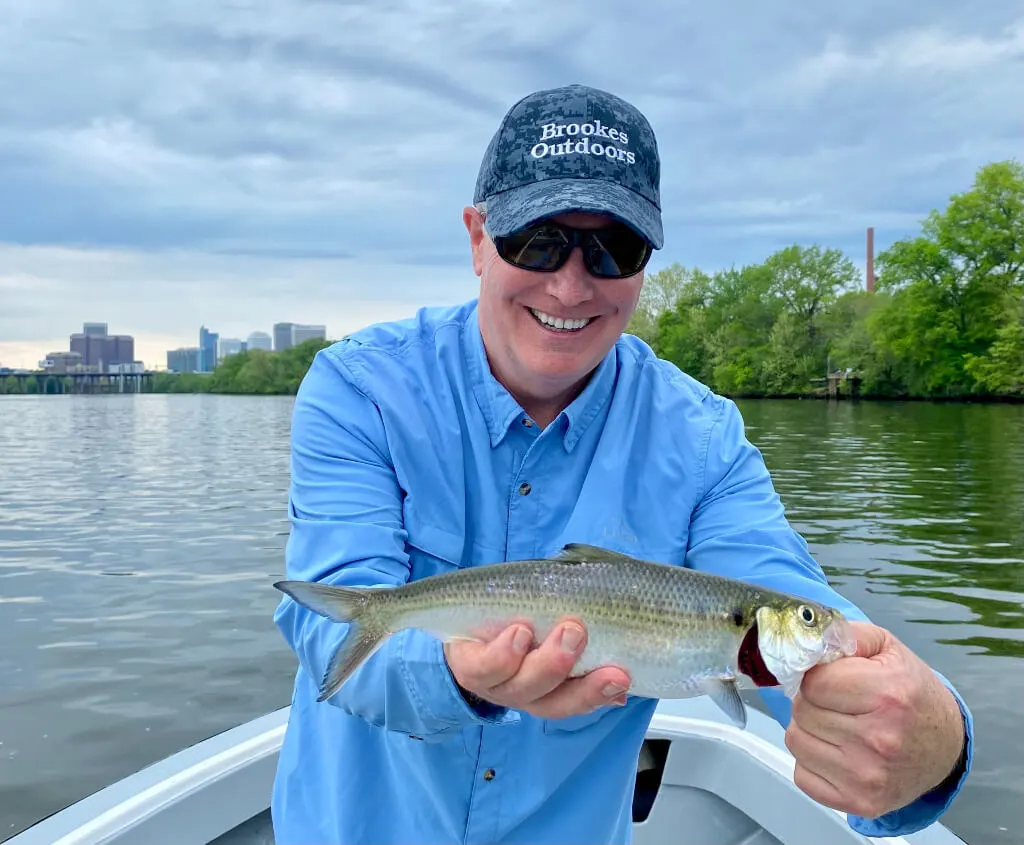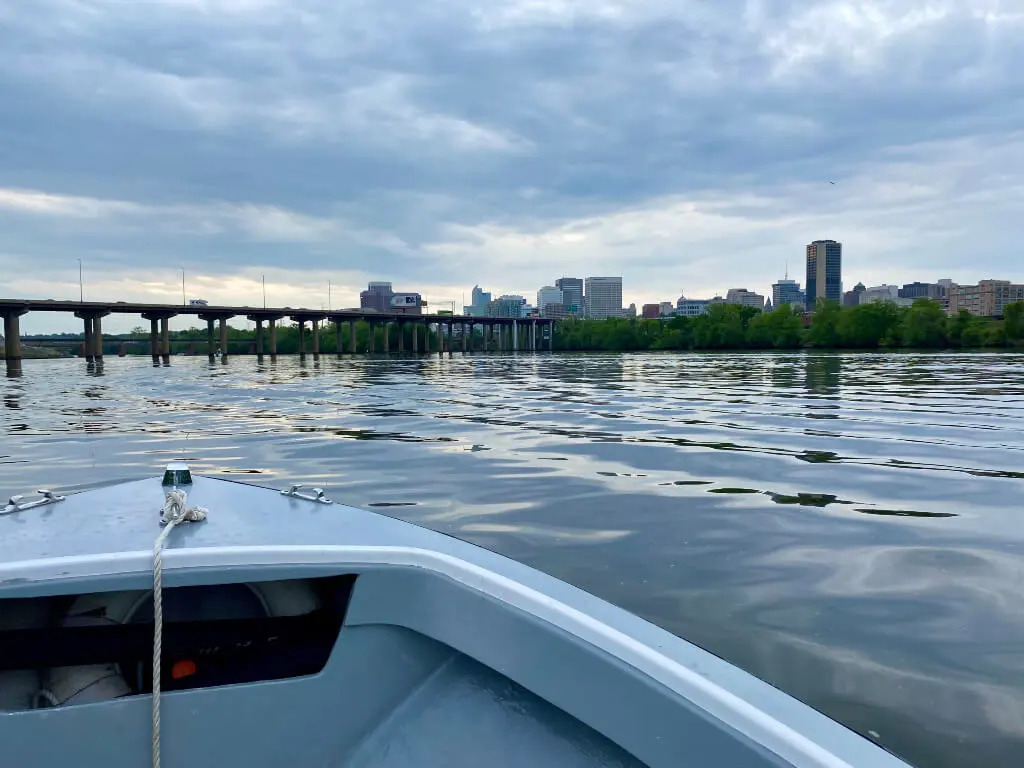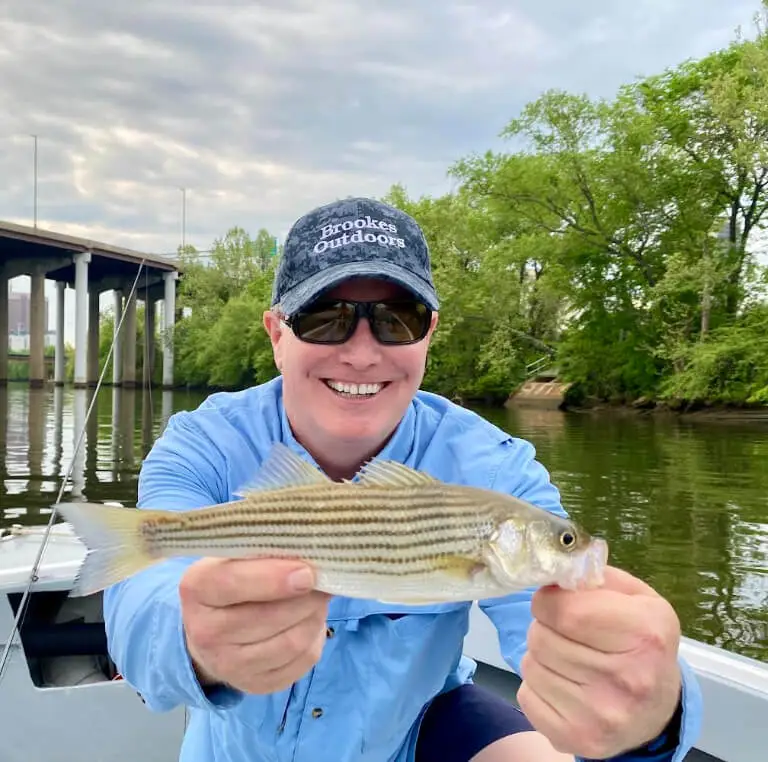Fly Fishing Virginia’s Shad Run

Nothing lights up online fly fishing message boards, fills up email inboxes or piles up strings of texts of Old Dominion river anglers more than the arrival of shad from the Atlantic Ocean to local rivers on their annual spring spawning run.
Indeed, the posted picture of that first hickory or American shad catch of the season brings the lucky angler near rock-star status, accompanied by endless online thumbs-up, fist pumps and high fives.
Yes, it’s that big of a deal.
The shad run often starts around the beginning of calendar spring, marking the official end of dark and dreary winter. More importantly, it signals the unofficial beginning of the fishing high season in the Commonwealth of Virginia.
As a Virginia Department of Wildlife Resources (DWR) fisheries biologist once put it to me: “Fishing for shad in Virginia is a rite of spring.” I like that sentiment—and right up there with spring turkey season for the hunter—I couldn’t agree more.
And some may not be aware that shad have a storied history here in Virginia. For instance, the legendary large runs of this migratory fish were an important source of sustenance for Native Americans and the first settlers.
Though accounts differ, some claim George Washington was a big shad fan, too.
Unfortunately, the story about the shad run saving the Continental Army at Valley Forge from starvation in the winter of 1777-1778 is probably apocryphal. But, despite this, many anglers still affectionately refer to shad as the “founding fish.” (See John McPhee’s book, The Founding Fish, for an interesting take on the shad’s role in American history and culture.)
Fly anglers usually throw their shad back, but harvesting Atlantic Coast shad for the table was at one time quite popular—and a big commercial activity. Some fishers still chase these feisty fish for their roe—which some folks swear by as not only tasty, but rich in vitamins.
While both shad species are fun to fish for, hickories and Americans differ in fundamental ways.
The hickory (or silver) shad is affectionately known as the “poor man’s tarpon.” With its superior (or upturned) mouth and protruding lower jaw, it looks a lot like the saltwater fish of Florida fame. As fish from the salt, hard-swimming shad will put a serious bend in your fly rod, but hickories are also well known for their aerial acrobatics once hooked—once again like those gravity-defying, tail-walking tarpon.
The American (or white shad) are identified by a symmetrical (or terminal) mouth with equal upper and lower jaws, and have more of a football shape to them. At their biggest, Americans run 20 inches to 22 inches, while hickories go a bit smaller at about 15 inches to 18 inches, according to DWR.
While it naturally varies a tad due to weather, the shad run in Virginia rivers usually peaks about mid-April, but will run into May.
Two of the top waters for shad in the Commonwealth of Virginia are the Rappahannock and James Rivers. Angling for this sport fish in these Chesapeake drainages can be done from the shore, while wading, or from watercraft, depending on the location.
But don’t overlook the more southerly, less-pressured Nottoway and Blackwater Rivers. These Albemarle Sound drainage rivers are not wadable and have limited shore fishing, so the shad fishing is best done from watercraft. The Potomac River to the North in District of Columbia waters is also an iconic shad fishery.
Gearing Up for Shad

In terms of catching shad, a 9-foot, 6- to 8-weight fly rod with a sinking line (or head) and a section of straight 0x to 2x fluorocarbon leader/tippet will do the trick; some folks will go as high as 25-lb. test leader/tippet.
Both fish are good feeders and will hit the tried-and-true, brightly-colored (pink, chartreuse, yellow, and red) shad dart or the venerable chartreuse and white Clouser Minnow.
Try adding a green damsel nymph as a dropper off of your shad dart or Clouser rig. Don’t ask me why these anadromous fish will eat a damsel nymph, but my experience over the years is that it works!
Some other sage advice from DWR: “The hickory is more likely to take a bait near the surface, while the American is best targeted deeper in the water column.”
Another DWR fisheries biologist shared an additional good tip for getting shad on the line, “While Americans (the fish, not the people!) prefer to move upstream in deeper channels, don’t overlook the backwater areas of the river for hickories.”
That’s solid advice from my experience.
Of course, with the chance of spring rains, do yourself a favor by checking the U.S. Geological Survey website (usgs.gov) for current and historical water height and flow rates before heading to the river.
It may save you an unnecessary—and deeply disappointing—trip to a river that’s
raging with runoff from a way-upstream rainfall, making it both unfishable and unsafe.
Lastly, check out DWR’s very cool Shad Cam at the Bosher’s Dam fishway on the James River. It’s a great opportunity to see these amazing fish make their run home after four or five years at sea.
Among some anglers, Americans are the prized catch due their bigger size and relative fewer numbers in comparison to healthier stocks of hickories.
But if you want to harvest shad, be sure to check the DWR websites for the latest Virginia regulations, including current moratoria which, in the past, have included American shad as well as alewife and blueback herring, a common bycatch during the shad run.

Shad Identification
To help you identify these fish, make sure to read “American or Hickory? ID your Shad Catch.”
Speaking of bycatch, in the James Rover, for instance, you also have a pretty good chance of hooking into a striper (striped bass) and white perch while the shad run is on. Landing all three is known locally as the “James River Slam.”
Of course, you’ll need a Virginia fishing license. In addition, you must also register with the Virginia Marine Resources Commission’s (VMRC) Fisherman Identification Program—it’s free!—since you’re fishing for a saltwater fish in freshwater.
The end of winter and the arrival of spring means many things to many people, but to Virginia’s tidal river anglers, it means primarily one thing, and one thing alone: The shad are coming! The shad are coming!
Did You Find This Article Helpful?
Stay up to date with the Dark Skies Fly Fishing monthly newsletter for free and receive the latest posts in fly fishing news, tricks, tips, and techniques, stream reports, as well as updates on new flies added to the Online Store and exclusive discounts!
Sign Up Now